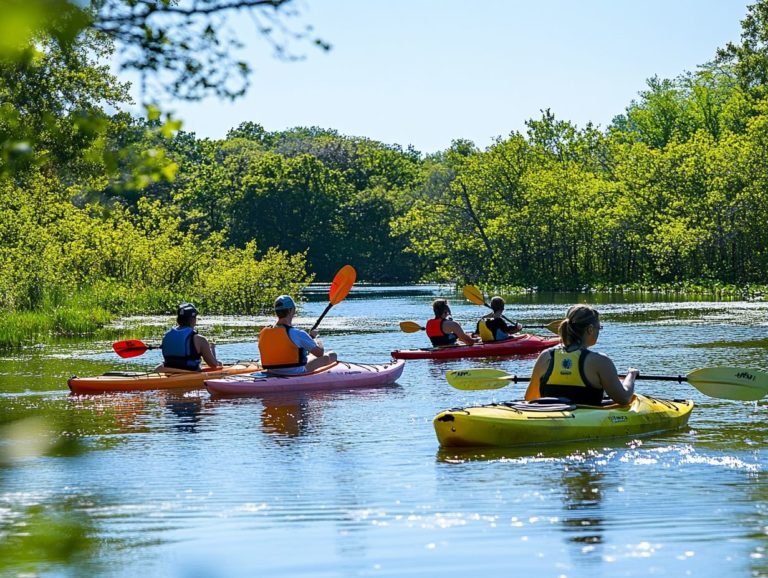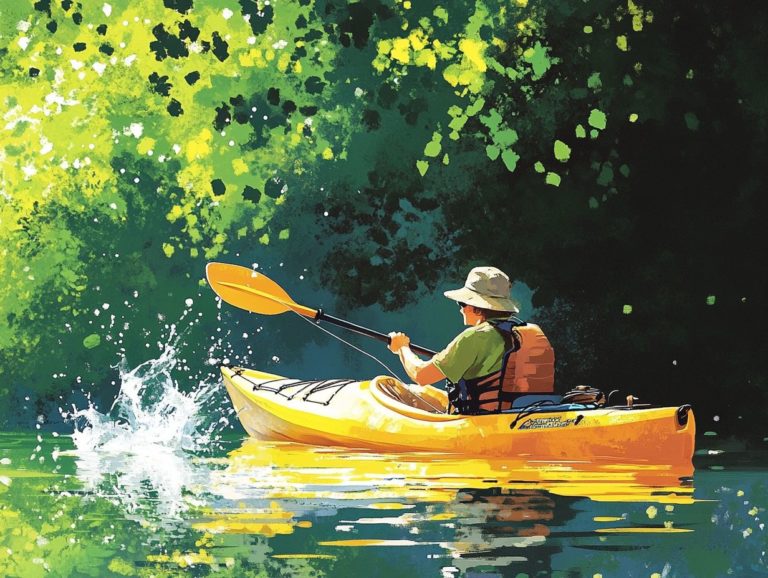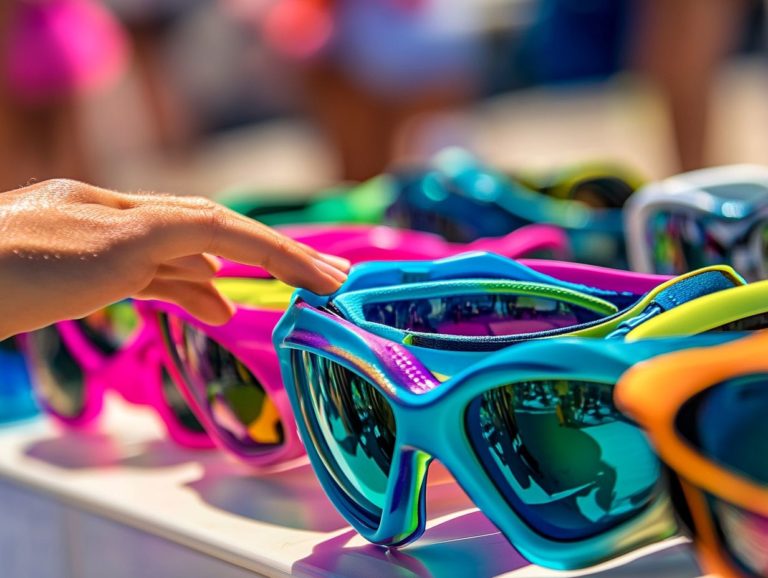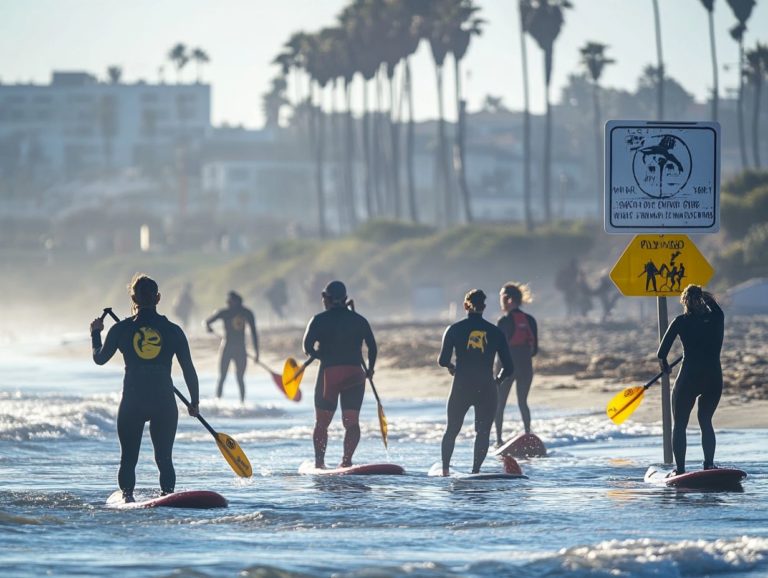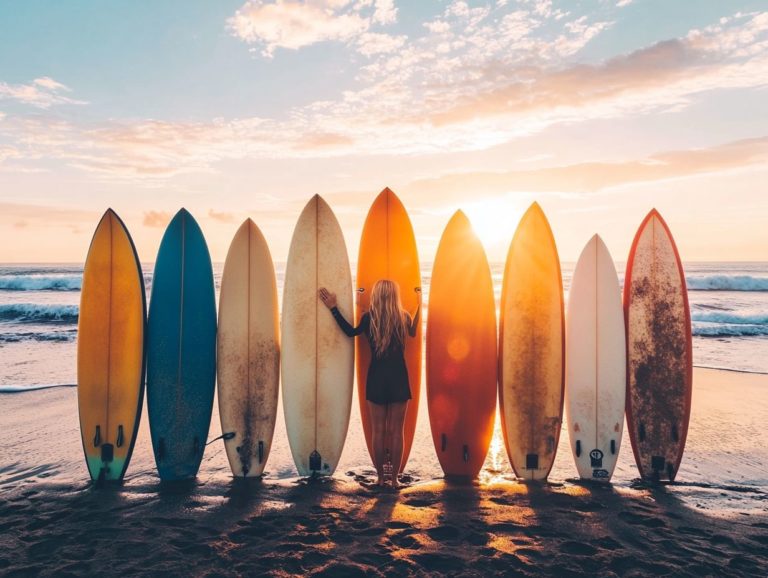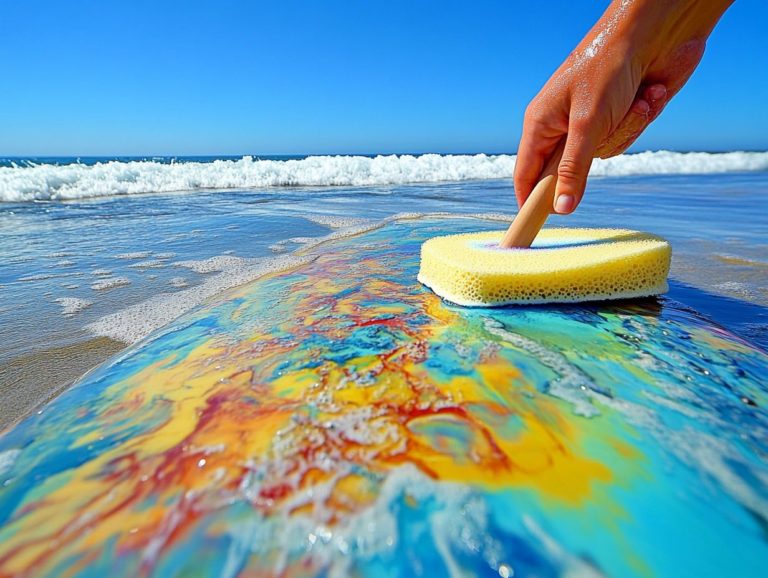Understanding Different Types of Paddle Boards
Dive into the world of paddle boarding! Connect with nature while enjoying an exhilarating adventure.
Whether you re just starting out or consider yourself a seasoned paddler, selecting the right board can greatly enhance your experience on the water.
This article delves into the various types of paddle boards, comparing inflatable and solid options, and guiding you on how to choose the ideal one to suit your needs.
Discover essential techniques for beginners, advanced tips for the more experienced, and must-have accessories to ensure your paddle boarding outings are enjoyable and safe.
Dive in to uncover everything you need to make the most of your paddle boarding journey!
Contents
Key Takeaways:
- When choosing a paddle board, consider factors such as weight, skill level, and intended use.
- Inflatable paddle boards are more convenient for storage and transportation, while solid paddle boards offer better stability and performance in the water.
- Essential skills for paddle boarding include proper posture, paddle technique, and balance. Experienced paddle boarders should focus on advanced techniques and safety precautions.
What is a Paddle Board?
A paddle board is your go-to watercraft. It s great for leisure, exercise, and sports. Typically available in both rigid and inflatable options, paddle boards have surged in popularity due to their remarkable ability to adjust to different water conditions.
Whether you’re into SUP (Stand Up Paddleboarding) yoga, fishing, or surfing, understanding the types of surfboards can elevate your experience through distinct construction materials and shapes tailored to meet diverse user needs. This makes them perfect for everyone, from novices to seasoned paddlers.
Different paddle board designs, like touring boards for those longer escapades and all-around boards for everyday use, play a vital role in helping you find the perfect fit for your paddling adventures.
Paddle boarding offers a wealth of benefits. It improves your core strength and balance while also providing a serene recreational activity that lets you connect with nature. The gentle rhythm of paddling can boost your cardiovascular fitness, while the stability of the boards invites you to explore local waterways, offering a unique perspective of your surroundings.
Whether you re enjoying a peaceful day on the lake or seeking an adrenaline-pumping surf adventure, paddle boards deliver an engaging way to exercise and unwind.
Inflatable vs. Solid Paddle Boards
When you’re weighing the options between inflatable and solid paddle boards, it’s crucial to recognize that each type presents its own unique set of advantages and disadvantages, perfectly suited to various activities, skill levels, and water conditions.
Comparison of Different Types
Understanding the differences between various types of paddle boards like all-around, touring, fishing, surf, beginner, and performance boards can elevate your paddle boarding experience by ensuring your choice aligns with your intended activities.
Each board type has advantages for different activities. If you re just starting out, all-around boards are your best bet; they re designed for stability and versatility, helping you adapt to different water conditions with ease.
If long-distance exploration excites you, touring boards, with their sleek, elongated shapes, offer unmatched glide and speed.
Fishing enthusiasts will love boards that come with extra storage options, while surf boards, crafted for catching waves, feature shorter lengths and enhanced maneuverability. With the growing trend of SUP yoga, you ll find specialized boards that boast wider designs and stable platforms, perfect for maintaining balance during your practice.
If you re planning family outings, look for boards that prioritize stability and space, allowing for comfortable rides with children or pets. By grasping these unique characteristics, you can pinpoint the ideal board that fits your adventure perfectly.
Choosing the Right Paddle Board for You
Choosing the ideal paddle board requires careful consideration of several key factors, including your skill level, intended use, and preferred board type. Each of these elements can profoundly influence your overall stand-up paddleboarding experience.
Factors to Consider
When selecting a stand-up paddleboard (SUP), it s essential to consider several key factors: performance, stability, maneuverability, storage options, and construction materials. These elements are critical for ensuring an optimal experience on the water.
Understanding how each of these factors interacts can significantly enhance your paddling adventure. For example, the choice of material is pivotal. Boards made from EPS foam are generally lightweight, making transport and maneuvering a breeze. In contrast, carbon fiber boards offer a stronger, more durable design that boosts performance.
Epoxy resin is another crucial aspect, creating a robust surface that resists scratches and impacts. This durability is vital for maintaining stability during transitions and navigating choppy waters. Thinking about storage solutions will help ensure your paddle board seamlessly integrates into your lifestyle, leading to more enjoyable outings on the water.
Paddle Boarding Techniques and Tips
Mastering paddle boarding techniques and honing essential skills are critical for elevating your overall SUP experience. Whether you re a beginner eager to learn or an experienced paddler looking to refine your skills, investing time in these fundamentals will undoubtedly improve your time on the water.
Essential Skills for Beginners
Master skills like balance and paddling technique. Learning safe ways to enter and exit the water is crucial for a truly enjoyable paddle boarding experience.
These skills set the stage for a successful paddling journey. Comfort plays a big role in your enjoyment, so focus on stability by maintaining a low center of gravity and keeping your feet shoulder-width apart. Practicing proper paddling techniques like engaging your core and keeping the paddle vertical will enhance your efficiency and minimize fatigue.
Learning safe transitions in and out of the water is important to avoid slips and falls, especially under varying conditions. These practical tips will boost your confidence and make each outing safer and more enjoyable.
Tips for Experienced Paddle Boarders
For experienced paddle boarders, advancing your skills through techniques such as efficient paddling, dynamic turning, and mastering navigation in wind and current is essential for optimizing performance on the water.
To elevate your proficiency, explore advanced stroke mechanics to enhance energy transfer with each paddle stroke. Practicing edge control during turns will allow for quick pivots, making navigation in tight spaces easier.
Understanding how various weather patterns affect water conditions sharpens your decision-making skills, allowing you to plan routes strategically. Incorporate cross-training exercises like yoga or strength training to improve overall stability and endurance, ensuring you remain balanced and agile, even in challenging conditions.
Accessories for Paddle Boarding
Enhancing your paddle boarding experience means incorporating a range of carefully selected accessories that improve performance, ensure safety, and add convenience and enjoyment to your time on the water.
Must-Have Items for an Enjoyable Experience
To ensure you enjoy your paddle boarding experience, there are certain must-have items you can’t overlook, including safety gear, storage solutions, and performance-enhancing equipment.
These essentials not only boost comfort and efficiency but also prioritize safety while exploring tranquil waters. For instance, a personal flotation device (PFD) is critical for your safety in case of an accidental fall, while a whistle serves as a reliable distress signal. Waterproof bags are perfect for safeguarding your belongings from splashes or unexpected rain, making it easy to carry essentials like snacks or your phone.
Investing in proper paddles can also enhance stroke efficiency, allowing for longer outings without fatigue. Together, these elements create a seamless paddle boarding adventure, maximizing both fun and safety on the water.
Frequently Asked Questions
Explore the Exciting World of Paddle Boards
There are many types of paddle boards each with unique features. These include all-around, touring, inflatable, surfing, racing, and fishing options.
What is an All-Around Paddle Board?
An all-around paddle board is the most versatile type. It s perfect for beginners and suitable for various water conditions.
What is a Touring Paddle Board?
A touring paddle board is designed for longer trips. It offers stability and speed, making it ideal for paddling in open water.
When Should I Use an Inflatable Paddle Board?
Inflatable paddle boards are great for storage and travel. They can be easily deflated and packed in a backpack.
Can I Use a Surfing Paddle Board for Other Activities?
Surfing paddle boards are designed for catching waves, but they can also be used for leisurely paddling in calmer waters.
What Should I Consider When Choosing a Racing Paddle Board?
When selecting a racing paddle board, think about the board’s length, width, and shape. Additionally, consider your skill level and the type of racing you ll participate in.
Don t wait! Find your perfect paddle board today!

